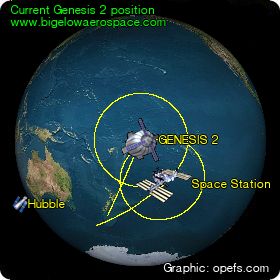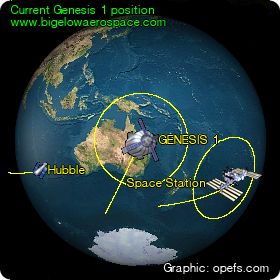|
|
||
|
Bigelow Aerospace
BIGELOW
AEROSPACE
|
||
|
..
By Erich Habich (Jul 13, 2006)
Robert T. Bigelow has a vision: to enable privately funded expeditions a stay in space. The method to achieve his goal is based on the "TransHab" concept, the patents to which Bigelow bought in 2000 from NASA. Bigelow's track record as entrepeneur is well proven as founder and owner of the Budget Suites hotel chain. The Genesis 1 is the first of two 1/3 scale prototype models of the future line-up of space habitats, which will range from the Galaxy class, to the BA330, which will offer 330m³ of space (ISS has 425m³ volume). Genesis 1 is scheduled to remain
in space for 5 years, at a height of 500km (310miles). During this time
the hull will be tested, which in the final BA330 version will composited
of Kevlar and have 40cm (16in) thickness.
NASA senior engineer William Schneider, who conceived of the TransHab concept, is not in doubt that by 2010 the first Space Hotel will be orbiting Earth. Of course, to reach the commercial space complex the transportation must be sorted out.
Images in this section copyright Bigelow Aerospace. All rights reserved. Further information:
|
||
|
Please visit the Bigelow Aerospace website for the latest news.
A simple javascript means that
you don't have to reload this page manually.You can use the images
|
||
"Our Planet Earth From Space" concept and code implementation - Copyright Erich Habich © 2003-2004. The images on this website are offered under a Creative Commons Lizenz, the limitation being that you must not download the same image repeatedly in intervals of more often than once every 20 min. Questions ?: |
||
|
Launched July 12, 2006 .. Launched on a Dnepr rocket (an ICBM converted for commercial use) on July 12, 2006, Genesis I began Bigelow Aerospace's journey to revolutionize space commerce. The subscale technology demonstrator, which inaugurated the ISC Kosmotras Space and Missile Complex near Yasny, Russia, met with unprecedented success and was a unique technical, legal and financial pathfinder in a number of ways. Specifically, Genesis I:
The spacecraft remains in orbit and is operational today, continuing to produce invaluable images, videos and data for Bigelow Aerospace. It is now demonstrating the long-term viability of expandable habitat technology in an actual orbital environment. |
||
|
Launched June 28, 2007 .. Genesis II was successfully launched from the Kosmotras Space and Missile Complex near the town of Yasny on June 28, 2007. Like its predecessor, Genesis II is testing and validating the technologies necessary to construct and deploy a full-scale, crewed, commercial orbital space complex.
Although externally, Genesis II may look like an exact
duplicate of Genesis I, the similarities end there. Genesis II contains
numerous systems not flown on its predecessor such as additional cameras,
sensors, a Biobox, a reaction wheel and the interactive Space Bingo game.
Moreover, Genesis II afforded members of the general public the chance
to participate in BA's efforts via the "Fly
Your Stuff" commercial pilot program.
Genesis II contains 22 cameras on both the interior
and outside of the spacecraft - nine more than Genesis I. The vision system
includes articulated cameras with dual FireWire and Ethernet interfaces,
as well as a wireless boom camera for exterior shots. Space-to-ground communications
are provided by UHF, VHF and S-band antennas.
Magnetic torque rods, GPS and sun sensors and a reaction-wheel system provide attitude control and stabilization, as Genesis II does not have any propulsion of its own. Since its launch, Genesis II has been providing a cornucopia
of data and images back to Bigelow Aerospace's Mission Control Center in
North Las Vegas, Nevada. It has also successfully tested the world's first
in-orbit image projection system and will continue to set the stage for
BA's future manned orbital complexes.
|
||
|
||
|
..
|
||
| FAIR USE NOTICE: This page contains copyrighted material the use of which has not been specifically authorized by the copyright owner. Pegasus Research Consortium distributes this material without profit to those who have expressed a prior interest in receiving the included information for research and educational purposes. We believe this constitutes a fair use of any such copyrighted material as provided for in 17 U.S.C § 107. If you wish to use copyrighted material from this site for purposes of your own that go beyond fair use, you must obtain permission from the copyright owner. | ||
|
|








